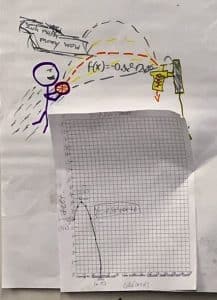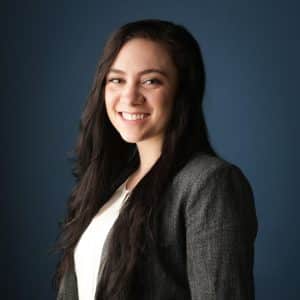A Mastery-Based Math Teacher’s Journey, Part 3 – Moving Away From “Covering” Everything
CompetencyWorks Blog
 This is the third post in a four-part series by Ashley Ferrara about her ongoing journey to develop a mastery-based approach to teaching mathematics. She is a teacher and interim acting assistant principal at the Academy for Software Engineering in New York City, a member school of the Mastery Collaborative.
This is the third post in a four-part series by Ashley Ferrara about her ongoing journey to develop a mastery-based approach to teaching mathematics. She is a teacher and interim acting assistant principal at the Academy for Software Engineering in New York City, a member school of the Mastery Collaborative.
Welcome back! I hope the last post left you with more questions and a few aspirations for wherever you may be on your mastery journey. I was discussing my mastery skills and rubrics that aimed to cover every bit of content on the state exam. This resulted in incredibly long assessments! I no longer recommend that approach, but it illustrated a key step in my mastery-based mathematics journey. Now I want to discuss the lightbulb moment that happened next.
The Lightbulb: Function families are part of the repeating mathematics of my Algebra 1 curriculum.
This lightbulb did not come easily and was a result of a great deal of frustration around our curriculum and the anxiety over feeling like I needed to test everything. I had prided myself on being a teacher who did not teach to the test, yet I was staring at mastery skills and rubrics that were created out of a need to cover everything on the state exam. I was a walking contradiction, and it was exhausting.
Mastery is intended to help bring out the “big rocks” of a curriculum, and I had let my anxiety over “covering it all” turn some pebbles into a bunch of boulders. But mastery-based learning is a long game, full of iteration, and this was a pivotal point where my co-teacher Stephanie Iovan and I identified yet another repeating pattern in our curriculum—functions—and created the mastery skill and rubric below.

Let’s break down how Mastery Skill 11 can “absorb” many of my unit-specific (and function-specific) mastery skills. I’ll also address how I do not feel that this would harm my ability to know where students are at with function-specific content, because that was a big concern of mine when I made this leap.
First, I think the strongest part of the Mastery Skill 11 rubric was “I can identify the function family given a representation (table, graph, and/or scenario).” The major evolution here is that we combined the representations. Previously, we had treated each representation separately, both in the mastery rubric and in class (this was discussed in my second blog post). We taught each one explicitly, with its own tips and tricks, and then moved onto the next. Instead of teaching about linear functions holistically, one day we were asking students to memorize “how to figure out if a table is linear,” the next day they had to memorize “how to tell if a graph is exponential,” and so on. Additionally, I realized that my classwork, homework, and assessments were strongly signaling students about which function family to use, whereas the New York state exam rarely did.
In not teaching function families and their different representations interchangeably, I was not giving my students the opportunity to deeply understand the different function families. The unit title told students what type of function they needed to use for their answer. The state exam did not provide this luxury, and neither do most problems in real life.
Mastery Skill 11 allowed us to shift our instruction, because it allowed us to shift our assessments. Teachers often hear about “starting with the end in mind,” and my end (i.e., my mastery skills and rubrics) had always been function-family-specific. Naturally, my teaching had mirrored that. But Mastery Skill 11 enabled me to present a table, graph, or scenario and allow students the space to share what they were noticing and wondering, and to define functions based on commonalities they observed, rather than the ones I had pointed out to them. This was powerful.
Given that the lightbulb moment came mid-semester, the most significant shift happened in our mastery skills for the following school year, which you can see here: SY18-19 Year-Long Algebra Mastery Skills. Over the span of a few years, we had gone from 16 specific, standards-based, state-exam-driven skills down to six skills that were mostly year-long and showcased how mathematics repeats itself.
Here is an example of those year-long skills in action on an assessment. To boot, this assessment wasn’t created by me—it was taken directly from a prior state exam, and the mastery skills still worked! This was a huge moment for me, because for years I had felt like my state exam requirements were at odds with my mastery journey, yet here they had finally worked cohesively! Another massive bonus was the demise of the impossibly long assessments I had administered in the past.
Notably, two of our six mastery skills—the ones focused on quadratic equations and quadratic functions—were content-specific rather than year-long. My co-teacher and I made this decision because, even though our instruction and assessment had evolved, the high-stakes state exam had not gone away. In recent years, students had needed to get about 32 percent of the exam correct to earn a passing score, and questions about quadratic functions had comprised about a quarter of the exam content. As much as we embraced mastery-based learning, there were real-world considerations we needed to keep in mind to ensure success for our students. Moreover, we used many aspects of mastery-based learning in our work on quadratic functions, which we recognize as an important set of functions to understand regardless of the exam.
Your homework assignment from this blog post is to reflect on this question: ten years from now, what skill or skills do you want your students to still have from your class? We’ll dive into my own response to this question in my next, and final, blog post on strategies for mastery-based learning in a mathematics program.
Learn More:
- A Mastery-Based Math Teacher’s Journey, Part 1 – Initial (mis)Steps and the “Aha!” Moment
- A Mastery-Based Math Teacher’s Journey, Part 2 – Refining Mastery Skills and Assessment Strategies
- A Mastery-Based Math Teacher’s Journey, Part 4 – Embracing Problem-Solving and Further Refining Mastery Skills
- But What About The Test?
 Ashley Ferrara is a founding faculty member at the Academy for Software Engineering (AFSE), a public high school in New York City. She joined AFSE nine years ago and was an Early Career Fellow and Master Teacher with Math for America for seven of those years. After earning a bachelor’s degree in accounting from the University of Connecticut and working with a big-four accounting firm, she earned master’s degrees in mathematics education from Teachers College, Columbia University and educational leadership and administration from Bank Street College of Education. She also graduated from the New York City Department of Education’s Leaders in Education Apprenticeship Program (LEAP).
Ashley Ferrara is a founding faculty member at the Academy for Software Engineering (AFSE), a public high school in New York City. She joined AFSE nine years ago and was an Early Career Fellow and Master Teacher with Math for America for seven of those years. After earning a bachelor’s degree in accounting from the University of Connecticut and working with a big-four accounting firm, she earned master’s degrees in mathematics education from Teachers College, Columbia University and educational leadership and administration from Bank Street College of Education. She also graduated from the New York City Department of Education’s Leaders in Education Apprenticeship Program (LEAP).